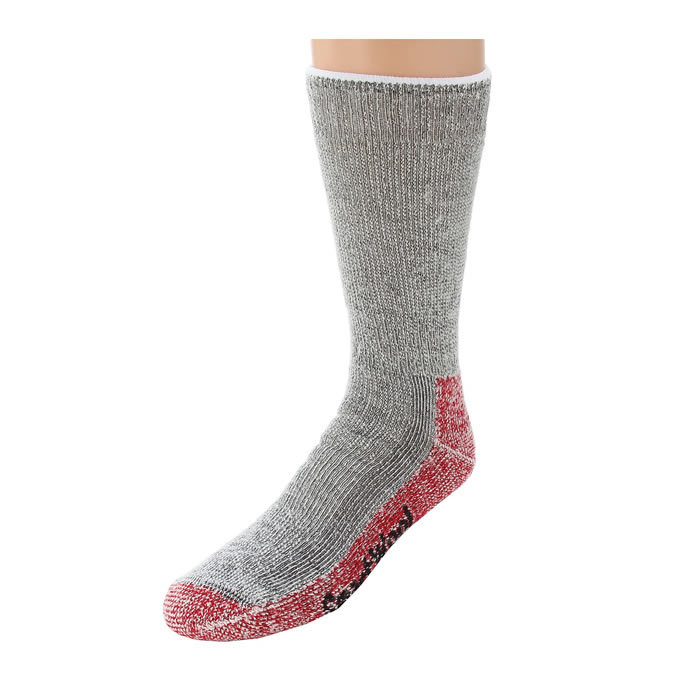Like most people, your sock drawer is probably crowded full of a wide variety of styles and colors of cotton socks. And a quality winter sock is nowhere to be found except for perhaps lost somewhere in your basement among old and rusting ski gear.
This is most unfortunate since wearing cotton socks in winter weather, particularly if you engage in strenuous activities, is a recipe for cold feet and frostbitten toes regardless of how fancy your winter boot might be. The reason? Simple. Wearing cotton socks during winter weather has the real potential to make your foot colder than if you wore no sock at all. How is this so?
Cotton Socks - Just Say No
The reason cotton socks are absolutely terrible choices for winter weather is because they have little insulation value and because they absorb and hold moisture. Worse yet, once a cotton sock is wet, it loses all insulation value. Even worse, a wet cotton sock then begins to coat your foot with a nice film of perspiration (which is water, remember?).
The end result of wearing cotton socks during the winter is that as your foot perspires the sock absorbs the moisture and then holds it, thereby coating your foot with a slick film of water while losing all insulation value in the process. And since a wet foot is a recipe for a cold foot, only if you really enjoy cold, wet, slimy feet should you ever consider wearing a cotton sock when engaging in outdoor winter activities.
Importance of Winter Socks
Because of the nasty effects of wearing cotton socks during the winter, if you spend much time outdoors in winter weather or participate in strenuous activities, a quality winter sock should be worn. The importance of wearing the right sock in winter weather cannot be understated. Wearing the latest, greatest and most expensive winter boot will do little to combat cold feet if you are wearing cotton socks.
 |
| A SmartWool Sock - Your Foot's Best Friend (read review) |
Winter socks aren’t just for outdoor use, either. If you suffer from cold feet while just sitting at home, as many people do, take a look at the socks you wear. If they are made from cotton, regardless of how thick or stylish they might be, you might as well be sitting around barefoot as the sock is potentially doing more harm than good.
So, what do you wear for a sock during the winter? Why, a dedicated winter sock of course. For cold weather, a sock made of wool, IsoWool, shearling, fleece and similar type synthetic materials must be used. The reason these types socks are excellent for winter wear is because if the socks get wet (due to excessive perspiration from the foot), the socks themselves do not lose their insulating properties. Additionally, the various styles of synthetic socks are also generally far thicker than a standard thin cotton sock, allowing the sock to absorb far more moisture. Moreover, and one of the neatest features of these types of socks, is that dry themselves out by simply being worn. The body heat of a person can actually dry out these types of socks.
Remember, in cold weather, particularly if you engage in strenuous activities, avoid any socks that has any cotton content in it. Your foot will be thankful to you for it.
Want a quick recommendation on a winter sock? Smartwool socks are my favorite choice, by far, in the mysterious world of winter socks. Read the review of Smartwool Socks for additional information. But there's nothing wrong with Wigwam socks or Thorlos, either (I just prefer the super-soft and snuggly feeling found in Smartwool).
The Sock Liner
The sock liner is probably the most forgotten about asset in keeping your feet dry, and thus warm, in cold weather. A sock liner pulls double duty, both by adding in a bit extra insulation value and, far more importantly, by transferring perspiration from the foot directly to the sock that the person wears. In essence, a sock liner takes the water off your foot and moves it to the sock, with the sock liner itself remaining perfectly dry (due to the construction of these types of socks). Because of this transfer of moisture, your feet remain perfectly dry (even during periods of great exertion), thus greatly increasing the probability of keeping your feet warm.
Thus, if you spend lots of time doing strenuous activities during the winter months, consider investing in a few pairs of sock liners. You'll be amazed at how effective these thin little socks are in keeping your foot dry and warm.
Sock liners, being the forgotten step-child that they are, aren’t the easiest to find anymore. When wool socks were popular, sock liners were more easily found since people often used them to protect against that “itchy, scratchy feeling” that wool socks caused. But with the arrival of more comfortable socks, sock liners have sort of gone out of style.
However, two online retailers do consistently sell various types of sock liners. You can find sock liners at Amazon and REI. Amazon has the widest variety of sock liners while REI sells the most "technical" liner socks (meant for skiing and winter hiking).
Next Page - The Snow Gaiter
